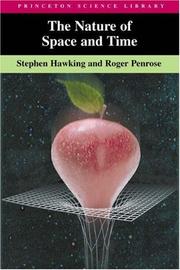Check nearby libraries
Buy this book

Einstein said that the most incomprehensible thing about the universe is that it is comprehensible. But was he right? Can the quantum theory of fields and Einstein's general theory of relativity, the two most accurate and successful theories in all of physics, be united in a single quantum theory of gravity? Can quantum and cosmos ever be combined?
On this issue, two of the world's most famous physicists - Stephen Hawking (A Brief History of Time) and Roger Penrose (The Emperor's New Mind and Shadows of the Mind) - disagree. Here they explain their positions in a work based on six lectures with a final debate, all originally presented at the Isaac Newton Institute for Mathematical Sciences at the University of Cambridge.
- How could quantum gravity, a theory that could explain the earlier moments of the big bang and the physics of the enigmatic objects known as black holes, be constructed? Why is it that our patch of the universe looks just as Einstein predicted, with no hint of quantum effects in sight? What strange quantum processes can cause black holes to evaporate, and what happens to all the information that they swallow? Why does time go forward, not backward?
In this book, the two opponents touch on all these questions. Penrose, like Einstein, refuses to believe that quantum mechanics is a final theory. Hawking thinks otherwise, and argues that general relativity simply cannot account for how the universe began. Only a quantum theory of gravity, coupled with the no-boundary hypothesis, can ever hope to explain adequately what little we can observe about our universe.
Penrose, playing the realist to Hawking's positivist, thinks that the universe is unbounded and will expand forever. The universe can be understood, he argues, in terms of the geometry of light cones, the compression and distortion of spacetime, and by use of twistor theory.
With the final debate, the reader will come to realize how much Hawking and Penrose diverge in their opinions of the ultimate quest to combine quantum mechanics and relativity, and how differently they have tried to comprehend the incomprehensible.
Check nearby libraries
Buy this book

Previews available in: English German
Subjects
Astrophysics, Cosmology, Quantum theory, Space and time, Astrophysik, Quanten Theorie, Raum und Zeit, Relativity Theory, Time, SpacePeople
Albert EinsteinShowing 5 featured editions. View all 19 editions?
| Edition | Availability |
|---|---|
| 1 |
zzzz
Libraries near you:
WorldCat
|
|
2
The Nature of Space and Time
October 15, 2000, Princeton University Press
Paperback
in English
0691050848 9780691050843
|
eeee
|
| 3 |
zzzz
Libraries near you:
WorldCat
|
| 4 |
zzzz
Libraries near you:
WorldCat
|
| 5 |
aaaa
Libraries near you:
WorldCat
|
Book Details
Edition Notes
Includes bibliographical references (p. [139]-141).
Classifications
External Links
The Physical Object
ID Numbers
Source records
Internet Archive item recordInternet Archive item record
Better World Books record
Library of Congress MARC record
Internet Archive item record
Internet Archive item record
marc_columbia MARC record
Work Description
Het verslag van een zeldzame confrontatie tussen twee kosmologische kopstukken.
De twee eminente Britse natuurkundigen Stephen Hawking en Roger Penrose hebben een tegengestelde visie op de toekomst van het heelal, hoewel beide proberen de algemene relativiteitstheorie te verenigen met de kwantummechanica. In dit boek komt naar voren hoezeer hun standpunten over het uiteindelijke lot van het heelal botsen, en hoe zij op verschillende wijze proberen het onbegrijpelijke proberen te begrijpen. (bron)
Community Reviews (0)
Feedback?History
- Created April 1, 2008
- 16 revisions
Wikipedia citation
×CloseCopy and paste this code into your Wikipedia page. Need help?
| July 29, 2024 | Edited by MARC Bot | import existing book |
| October 4, 2021 | Edited by ImportBot | import existing book |
| August 11, 2021 | Edited by ImportBot | import existing book |
| February 23, 2021 | Edited by ImportBot | import existing book |
| April 1, 2008 | Created by an anonymous user | Imported from Scriblio MARC record |














